In today’s competitive insurance landscape, a well-crafted business plan is essential for driving growth and achieving success. With this comprehensive guide, insurance companies can develop a robust marketing strategy that effectively targets their audience, drives brand awareness, and generates leads.
From analyzing market trends to leveraging digital channels, this plan Artikels the key elements of a successful insurance company marketing strategy.
Insurance companies face unique challenges in a rapidly evolving market. Understanding customer needs, staying ahead of competitors, and adapting to regulatory changes are just a few of the hurdles they must overcome. This guide provides practical tips and strategies to help insurance companies navigate these challenges and achieve their marketing goals.
Insurance Company Profile
Introducing [Company Name], a prominent insurance provider dedicated to safeguarding the future of our clients. Our journey began in [Year], driven by the mission to provide peace of mind and financial protection to individuals, families, and businesses. With a vision to be the most trusted and reliable insurance partner, we have consistently evolved to meet the ever-changing needs of our customers.
At [Company Name], we offer a comprehensive range of insurance products and services tailored to diverse needs. From traditional life and health insurance to specialized coverage for property, vehicles, and businesses, we strive to provide customized solutions that align with our clients’ unique circumstances.
Our unwavering commitment to customer satisfaction drives us to deliver exceptional service, ensuring prompt claims processing and personalized assistance whenever needed.
Target Audience and Geographic Focus
Our target audience encompasses individuals, families, and businesses of all sizes. We recognize that each segment has distinct insurance requirements, and we cater to their specific needs with tailored products and services. Our geographic focus extends across [Region/Country], with plans to expand our reach in the future.
We aim to become a trusted insurance provider, recognized for our unwavering commitment to excellence and customer-centric approach.
Market Analysis
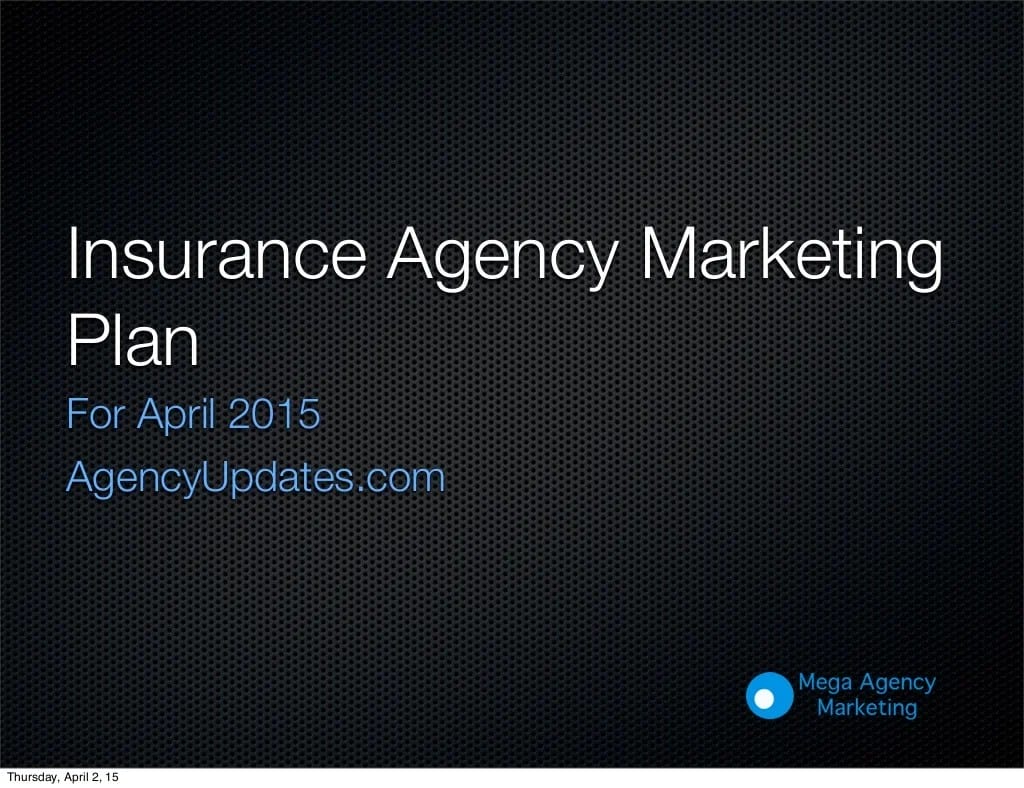
To ensure successful market penetration and sustained growth, it is crucial to conduct a thorough market analysis. This involves assessing the current market landscape, identifying key competitors, and understanding market trends and customer preferences.
Analyzing the market landscape provides insights into the overall size, growth potential, and competitive intensity of the insurance industry. By identifying key competitors and evaluating their strengths and weaknesses, we can gain valuable insights into their market strategies, pricing policies, and customer service offerings.
Market Trends and Customer Preferences
Understanding market trends and customer preferences is essential for staying ahead of the competition and meeting the evolving needs of policyholders. By monitoring industry trends, we can anticipate changes in consumer behavior, regulatory policies, and technological advancements. This enables us to adapt our products, services, and marketing strategies accordingly.
Customer preferences play a significant role in shaping the demand for insurance products. Conducting market research and surveys helps us gather insights into customer needs, expectations, and pain points. This information enables us to develop products that address these specific needs, ensuring customer satisfaction and loyalty.
Marketing Objectives

A comprehensive marketing plan requires a clear definition of marketing objectives and goals. These objectives serve as the roadmap for the insurance company’s marketing efforts and provide a basis for evaluating the effectiveness of implemented strategies.
The primary marketing objectives typically encompass:
Market Share and Brand Awareness
- Market Share: Increasing market share is a fundamental objective for insurance companies. By attracting new customers and retaining existing ones, the company aims to expand its presence in the market and secure a larger portion of the overall business.
- Brand Awareness: Building brand awareness is crucial for establishing a strong reputation and creating a positive perception among potential customers. The objective is to make the insurance company’s brand recognizable, memorable, and associated with trust and reliability.
Customer Loyalty
Fostering customer loyalty is paramount for long-term success in the insurance industry. Loyal customers are more likely to renew their policies, recommend the company to others, and provide valuable feedback. The objective is to build enduring relationships with customers by delivering exceptional service, resolving issues promptly, and consistently exceeding expectations.
Measurable and Achievable Targets
Setting measurable and achievable targets is essential for tracking progress and ensuring accountability. These targets should be specific, quantifiable, attainable, relevant, and time-bound (SMART). Examples of SMART targets include:
- Market Share: Increase market share by 5% over the next three years.
- Brand Awareness: Achieve a brand awareness level of 80% among the target audience within two years.
- Customer Loyalty: Increase customer retention rate to 90% by the end of the fiscal year.
Target Audience
Defining the target audience is pivotal in crafting effective marketing strategies. It involves identifying the ideal customer profile and segmenting them based on relevant criteria to tailor personalized marketing campaigns.
The insurance company’s target audience can be segmented based on various factors such as demographics, psychographics, and insurance needs.
Demographics
Demographic segmentation divides the target audience based on factors like age, gender, income, location, and education. This information helps tailor marketing messages to resonate with specific demographics.
- Age: Segmenting by age groups allows for targeting different life stages and insurance needs. For instance, younger individuals may require coverage for life events like marriage or starting a family, while older individuals may seek retirement planning and long-term care insurance.
- Gender: Understanding gender-specific needs and preferences is crucial. For example, women may be more receptive to insurance products that address health and family-related concerns.
- Income: Segmenting by income level helps target products and services that align with different purchasing power. High-income individuals may seek comprehensive coverage and premium products, while those with lower incomes may prioritize affordable options.
- Location: Geographic segmentation considers regional differences in insurance needs and regulations. For example, coastal areas may have higher demand for flood insurance, while earthquake-prone regions may require earthquake coverage.
- Education: Education level can influence insurance needs and preferences. Individuals with higher education may be more aware of insurance options and have a greater appreciation for long-term financial planning.
Psychographics
Psychographic segmentation categorizes the target audience based on personality traits, values, attitudes, and lifestyles. This information helps create marketing messages that connect with customers on an emotional level.
- Personality Traits: Understanding personality traits like risk aversion, conscientiousness, and openness to experience can help tailor marketing messages to resonate with specific personality types.
- Values: Identifying core values such as security, stability, and financial well-being allows for creating marketing campaigns that align with customers’ values.
- Attitudes: Attitudes towards insurance, risk management, and financial planning influence purchasing decisions. Targeting customers with positive attitudes towards insurance can increase receptiveness to marketing messages.
- Lifestyles: Segmenting by lifestyle factors like travel habits, hobbies, and family dynamics helps tailor insurance products and services to meet specific lifestyle needs.
Insurance Needs
Segmenting the target audience based on insurance needs ensures that marketing campaigns address specific pain points and offer tailored solutions.
- Personal Insurance: This category includes products like life insurance, health insurance, and disability insurance, which cater to individuals and families.
- Property and Casualty Insurance: This segment covers products like homeowners insurance, auto insurance, and renters insurance, which protect property and assets.
- Commercial Insurance: Businesses of all sizes require coverage for property, liability, and employee-related risks.
- Specialized Insurance: This category includes niche products like marine insurance, aviation insurance, and professional liability insurance, which cater to specific industries and professions.
By segmenting the target audience based on these factors, the insurance company can develop personalized marketing strategies that resonate with each segment’s unique needs and preferences.
Marketing Mix
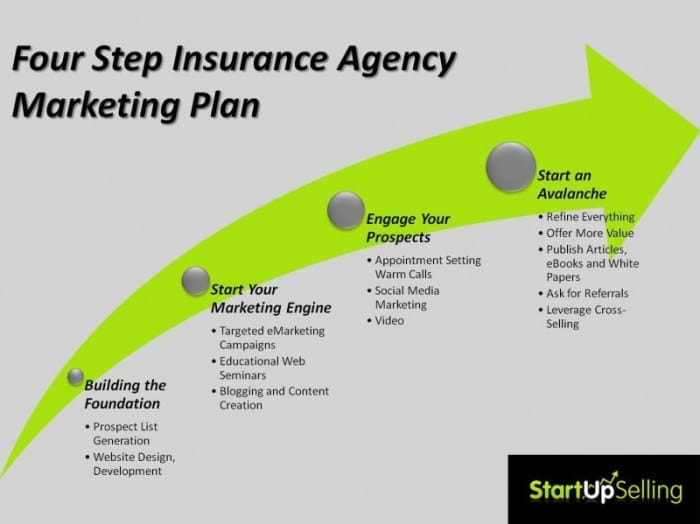
The marketing mix is a fundamental concept in marketing that encompasses four key elements: product, price, place, and promotion. These elements are strategically combined to achieve marketing objectives and influence consumer behavior. In the context of insurance companies, the marketing mix plays a crucial role in attracting and retaining customers, building brand awareness, and driving sales.
Optimizing each element of the marketing mix is essential for insurance companies to achieve their marketing objectives. This involves understanding the target audience, conducting market research, and developing strategies that align with the company’s overall marketing goals.
Product
The product in the insurance industry refers to the various types of insurance policies and services offered by the company. Insurance companies need to develop products that meet the specific needs and preferences of their target audience. This includes designing policies that provide comprehensive coverage, competitive rates, and flexible payment options.
Additionally, insurance companies should focus on creating innovative products that address emerging risks and trends in the market.
Price
Pricing is a critical element of the marketing mix that directly impacts the affordability and accessibility of insurance products. Insurance companies need to set prices that are competitive yet profitable. Factors to consider when determining pricing include the type of insurance policy, the level of coverage, the risk profile of the customer, and the prevailing market rates.
Insurance companies can employ various pricing strategies, such as offering discounts for multiple policies, loyalty programs, and flexible payment plans, to attract and retain customers.
Place
Place refers to the distribution channels through which insurance products are made available to customers. Insurance companies can distribute their products through a variety of channels, including direct sales, independent agents, brokers, and online platforms. The choice of distribution channel depends on the target audience, the type of insurance product, and the company’s resources and capabilities.
Insurance companies need to ensure that their products are easily accessible and convenient for customers to purchase.
Promotion
Promotion involves the activities and strategies used to communicate the insurance company’s products and services to the target audience. Insurance companies can use a variety of promotional tools and techniques, such as advertising, public relations, social media, and online marketing, to create awareness, generate leads, and drive sales.
Effective promotion requires a clear understanding of the target audience, their needs and preferences, and the most effective channels to reach them.
Examples of Successful Marketing Strategies
- State Farm: State Farm’s “Like a good neighbor, State Farm is there” advertising campaign has been running for over 40 years and has helped to establish the company as a trusted and reliable insurance provider.
- Progressive: Progressive’s “Flo” advertising campaign has been highly successful in creating brand awareness and generating leads. The character of Flo is relatable and memorable, and her appearances in commercials have helped to humanize the insurance industry.
- Geico: Geico’s “15 minutes could save you 15% or more on car insurance” advertising campaign is one of the most recognizable in the insurance industry. The campaign’s simple message and catchy jingle have helped to make Geico a household name.
Marketing Channels
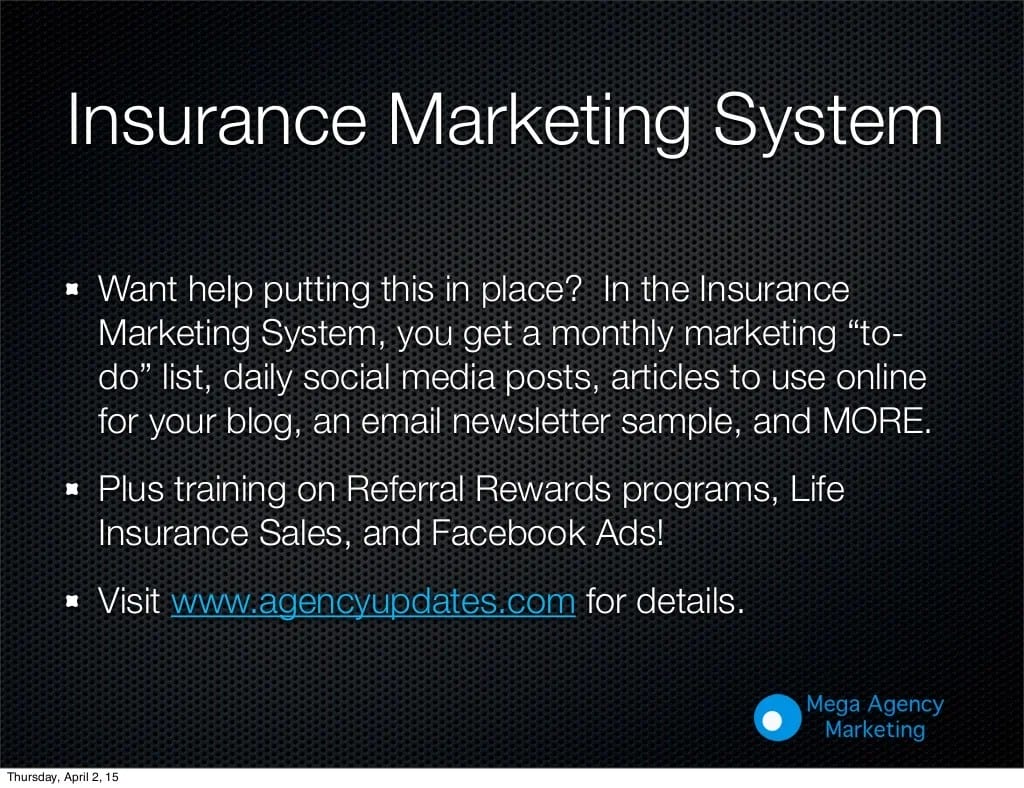
Identifying effective marketing channels is crucial for reaching the target audience and promoting insurance products and services. These channels serve as touchpoints to engage potential customers and build brand awareness. Each channel offers unique advantages and challenges, requiring a strategic approach to optimize marketing efforts.
A comprehensive marketing channel strategy involves a combination of digital and traditional channels to maximize reach and impact. It’s important to understand the advantages and disadvantages of each channel to allocate resources effectively and align marketing activities with customer preferences and behaviors.
Digital Marketing
Digital marketing encompasses various online platforms and technologies to connect with customers in the digital realm. It provides cost-effective and targeted marketing opportunities, enabling insurers to reach a wider audience and track results accurately.
- Advantages:
- Cost-effective and measurable
- Targeted advertising and personalized messaging
- Wide reach and global accessibility
- Real-time tracking and analytics
- Interactive and engaging content formats
- Disadvantages:
- High competition and cluttered digital landscape
- Potential for ad-blocking and privacy concerns
- Requires continuous content creation and optimization
- Need for technical expertise and digital marketing skills
Traditional Advertising
Traditional advertising methods involve offline channels such as print, broadcast, and outdoor advertising. These channels have a long history of reaching consumers and building brand recognition.
- Advantages:
- Mass reach and broad audience exposure
- Established trust and familiarity with traditional media
- Creates a sense of credibility and legitimacy
- Suitable for targeting specific geographic locations
- Disadvantages:
- Higher costs compared to digital channels
- Limited targeting options and personalization
- Less measurable and difficult to track results
- Potential for ad clutter and lower engagement
Word-of-Mouth Marketing
Word-of-mouth marketing relies on personal recommendations and referrals from satisfied customers. It’s a powerful form of marketing that leverages the credibility and trust inherent in personal relationships.
- Advantages:
- Highly credible and authentic
- Cost-effective and generates organic growth
- Builds strong customer loyalty and advocacy
- Spreads positive brand sentiment and reputation
- Disadvantages:
- Difficult to control and manage
- Relies on satisfied customers and positive experiences
- Slow and gradual process to generate significant impact
- Limited reach compared to digital or traditional channels
Content Marketing

Developing a robust content marketing strategy is essential to effectively educate and engage the target audience. By creating valuable and informative content that caters to their needs and interests, insurance companies can establish themselves as thought leaders in the industry and foster trust among potential customers.
Content marketing involves producing a variety of content formats, such as blog posts, articles, videos, infographics, and social media posts, that provide valuable insights, advice, and solutions to the target audience’s insurance-related queries and concerns. This content should be informative, engaging, and easily digestible, addressing common pain points and offering practical guidance.
Content Creation and Distribution
Creating high-quality content is a crucial aspect of content marketing. Insurance companies should focus on developing content that is relevant, informative, and engaging to their target audience. This can include blog posts, articles, videos, infographics, and social media posts that provide valuable insights, advice, and solutions to common insurance-related queries and concerns.
To ensure maximum reach and engagement, insurance companies should distribute their content through a variety of channels, including their website, social media platforms, email newsletters, and industry publications. Additionally, they can leverage influencer marketing and paid advertising to further amplify their content’s reach and visibility.
Content Promotion
Once content is created, it is important to promote it effectively to attract and retain customers. This can be done through a variety of channels, including social media, email marketing, paid advertising, and influencer marketing. By promoting content across multiple channels, insurance companies can increase its visibility and reach a wider audience.
In addition to promoting content through traditional channels, insurance companies can also use content syndication to distribute their content to a wider audience. Content syndication involves republishing content on other websites and platforms, such as industry blogs, news websites, and social media platforms.
This can help to increase the reach and visibility of the content, and attract new customers.
Social Media Marketing
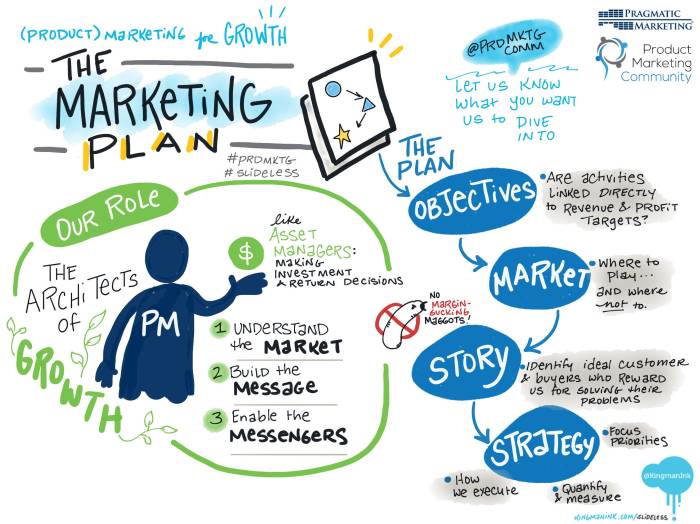
Social media platforms offer a powerful avenue to connect with the target audience and build brand awareness for insurance companies. Creating engaging social media content, such as posts, stories, and videos, can help capture attention and drive engagement. Additionally, running targeted social media ads can effectively reach a wider audience and generate leads.
Creating Engaging Social Media Content
To create engaging social media content, insurance companies should focus on creating visually appealing posts, stories, and videos that resonate with the target audience. This could include sharing educational content about insurance products and services, highlighting customer testimonials, or running contests and giveaways.
Targeted Social Media Ads
Targeted social media ads allow insurance companies to reach a specific audience based on demographics, interests, and behaviors. This can help ensure that ads are seen by individuals who are most likely to be interested in insurance products and services.
Social Media Analytics
Insurance companies should leverage social media analytics to track the performance of their social media campaigns and gain insights into audience engagement. This data can help refine social media strategies and optimize content for better results.
Email Marketing
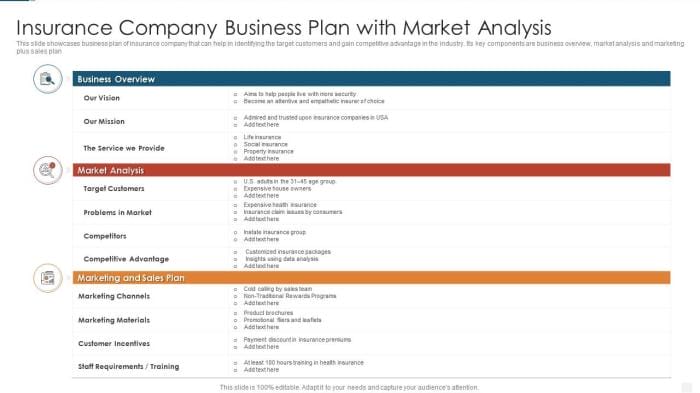
Leverage email marketing to connect with potential and existing customers, promoting products and services, sharing valuable content, and nurturing leads. Implement best practices to maximize engagement and conversions.
Building an Email List
Grow your email list strategically by offering incentives, creating lead magnets, and utilizing social media and website forms. Ensure compliance with data protection regulations and obtain explicit consent before adding contacts.
Targeted Email Campaigns
Craft targeted email campaigns tailored to specific segments of your audience. Personalize messages, segment your list based on demographics, behavior, and preferences, and use A/B testing to optimize subject lines and content.
Email Marketing Best Practices
Maximize open rates and conversions by implementing email marketing best practices. Optimize subject lines for clarity and impact, keep emails concise and visually appealing, and use strong calls to action. Monitor campaign performance and continually refine your strategy.
Performance Measurement and Evaluation
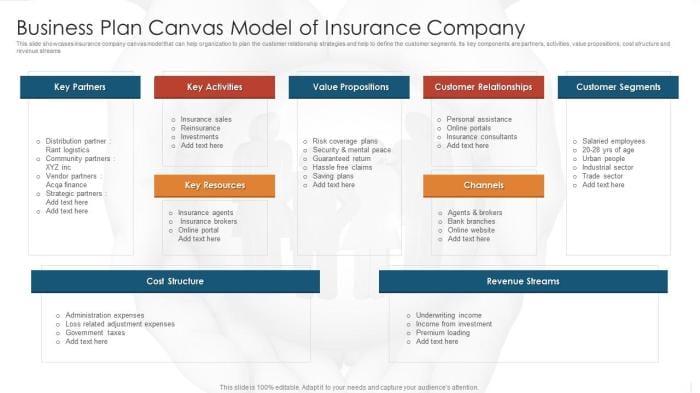
Measuring the success of marketing efforts is crucial for continuous improvement and optimization. By establishing key performance indicators (KPIs), insurance companies can track and analyze their marketing performance to identify areas of strength and weakness.
KPIs should align with the marketing objectives and overall business goals. Common KPIs include website traffic, lead generation, conversion rates, customer engagement, and brand awareness. Regular monitoring of these KPIs helps companies understand the effectiveness of their marketing campaigns and make data-driven adjustments to improve results.
Data-Driven Decision Making
Data analysis plays a vital role in evaluating marketing performance. By collecting and analyzing data from various sources, such as website analytics, social media engagement, and email campaign performance, companies can gain insights into customer behavior, preferences, and pain points.
This data-driven approach enables marketers to make informed decisions about their marketing strategies, optimize campaigns, and allocate resources effectively.
Continuous Improvement
Performance measurement and evaluation facilitate continuous improvement in marketing efforts. By identifying areas where campaigns fall short of expectations, companies can take corrective actions, refine their strategies, and implement new initiatives to enhance marketing effectiveness. This iterative process ensures that marketing efforts remain aligned with evolving customer needs and market trends, ultimately driving business growth.
Closure
In conclusion, a well-executed marketing plan is the cornerstone of a successful insurance company. By following the strategies Artikeld in this guide, insurance companies can effectively reach their target audience, differentiate themselves from competitors, and drive business growth. Embracing innovation, leveraging technology, and continuously measuring and refining marketing efforts are key to staying ahead in the ever-changing insurance landscape.
Frequently Asked Questions
What are some common challenges faced by insurance companies in their marketing efforts?
Insurance companies often face challenges such as a competitive market, evolving customer expectations, regulatory changes, and the need to maintain a positive brand image.
How can insurance companies effectively target their ideal customer profile?
Insurance companies can effectively target their ideal customer profile by conducting thorough market research, segmenting their audience based on demographics, psychographics, and insurance needs, and developing personalized marketing strategies for each segment.
What is the significance of content marketing for insurance companies?
Content marketing is crucial for insurance companies to educate and engage their target audience. By creating valuable and informative content, such as blog posts, articles, videos, and infographics, insurance companies can establish themselves as thought leaders and attract potential customers.
How can insurance companies leverage social media platforms to connect with their target audience?
Insurance companies can leverage social media platforms to connect with their target audience by creating engaging content, running targeted ads, and fostering interactions with customers. Social media provides a valuable channel for building brand awareness, driving traffic to the company’s website, and generating leads.
What metrics should insurance companies track to measure the success of their marketing efforts?
Insurance companies should track key performance indicators (KPIs) such as website traffic, leads generated, conversion rates, and customer satisfaction to measure the success of their marketing efforts. Regularly monitoring and analyzing these metrics allows insurance companies to identify areas for improvement and make data-driven adjustments to their marketing strategy.



